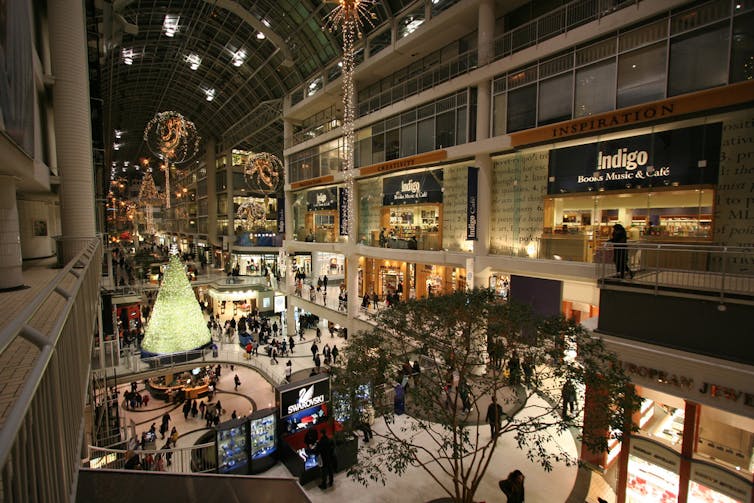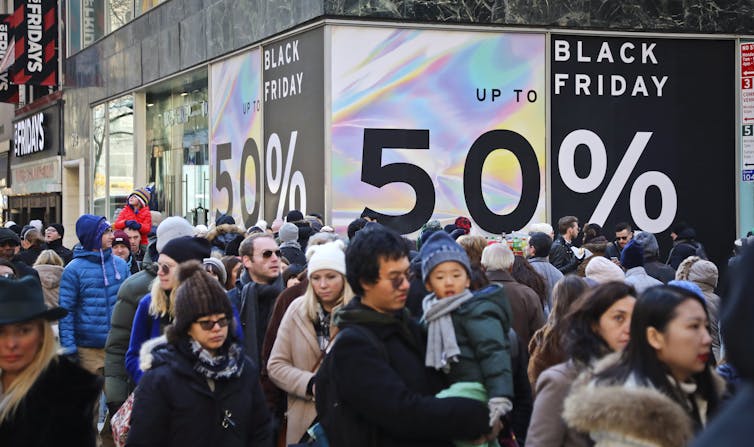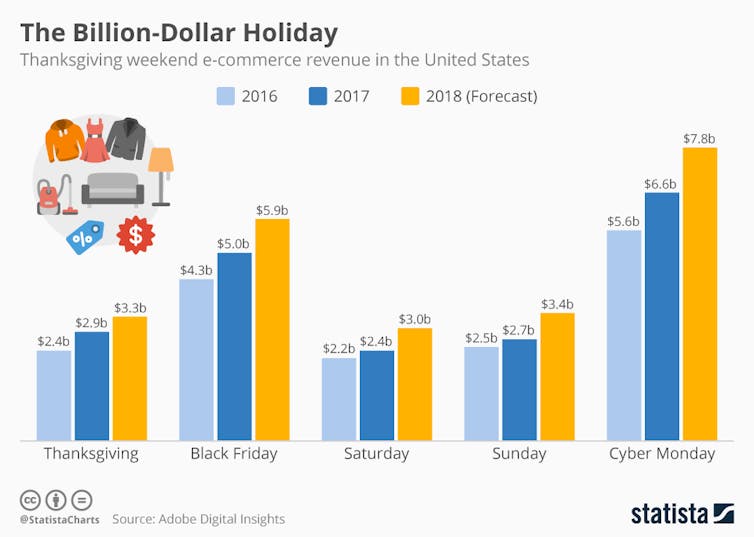
松林 /flickr, CC BY-SA
Norman Shaw, Ryerson University
Cyber Monday is online retailers’ response to the bricks-and-mortar marketing push of Black Friday. Online shopping is only set to increase, as smartphones and apps continue to capture more of the market.
In the United States, the fourth Thursday in November is Thanksgiving, a public holiday recognizing the first harvest gathered by the colonists. The streets are quiet, the shops are closed and families gather together to enjoy the holiday. Many businesses add to the occasion by giving their employees a day off on the Friday immediately following Thanksgiving Thursday.
And what do these people do? Go shopping!
Kicking off the shopping season
Marketing gurus have advertised the day as “Black Friday,” which heralds the start of the Christmas shopping season. One myth about the name is that it was the day when retailers started earning profits, or in other words, their bottom line changed from red for losses to black for profit.
In truth, the term was used by the Philadelphia police in the 1960s because of the traffic jams caused by shoppers flocking to snatch the bargains. Whatever the origin, we are now treated to Black Friday super sales when hordes of consumers wait until the stores open at midnight so that they can buy whatever is on sale at a bargain price.
Demonstrating the reach of the American marketing machine, the term has been used in other countries. Even though Canada celebrates Thanksgiving on the second Monday in October — and the U.K. does not even have a Thanksgiving holiday — retailers in these countries, and about 20 others, have learned that there is a large sales uplift with the marketing fever generated by Black Friday. The timing of their Black Friday sales follows the American one in late November, not because of Thanksgiving, but because it kicks off the Christmas shopping season.

(AP Photo/Bebeto Matthews)
The Monday after Black Friday
The hype of Black Friday encourages consumers to visit physical stores. But online retailers did not want to be left behind, so they created Cyber Monday. Rather than compete with Friday’s activity of actually going to a physical store, they appealed to the consumers who had just returned to work after a long weekend, but were still looking for bargains. These consumers could shop online, and so Cyber Monday was born in 2005. It has since grown to be a bigger shopping day than Black Friday.
Lonely shoppers
But which day is the busiest shopping day? Not Black Friday, not Cyber Monday, but Singles Day … in China. It all started in 2009 when the giant Chinese online company, Alibaba, wanted to encourage people to buy online. They saw the date Nov. 11 with all its ones (11:11) and offered on-line bargains on that day to singles.
Alibaba runs the online shopping site Tmall, which is the Chinese version of Amazon. They dominate business-to-consumer (B2C) online shopping, with close to 50 per cent of the Chinese market. This year, online sales on Singles Day topped $31 billion, which is over four times the volume of Cyber Monday.
Not only does China have the busiest online shopping day, they also have the highest penetration of online sales completed with smartphones. Twenty-three per cent of their Gross Merchandise Volume is online and over 50 per cent of that takes place via mobile phones. Mobile payment is made easy through WeChat Pay, owned by TenCent, and AliPay, owned by Ant financial. These two competitors dominate the buying and selling of merchandise and, with their acceptance of mobile payments, they are moving China to become a cashless society.

Statista/Adobe Digital Insights, CC BY
Shopping through apps
Online shopping has moved from the desktop to mobile. In 2011, only two per cent of online shopping was via mobile whereas in 2017, it was 60 per cent. In a survey conducted in 2017 by Pew Research Center of smartphone ownership, the majority of adults in 26 countries owned smartphones.
This penetration will continue to expand, and with the growth of new financial applications powered by technology (Fintech), mobile phones will become the vehicle of choice for online shopping.
Smartphones can also benefit physical stores. Apps help consumers compare products, find the nearest store, locate the item in the store, retrieve detailed product information and finally make the payment.
We can expect retail sales to continue to grow, in both clicks and bricks. We can also expect the mobile phone to be an integral component of shopping, in both clicks and bricks.![]()
Norman Shaw, Associate professor, Ryerson University
This article is republished from The Conversation under a Creative Commons license. Read the original article.




